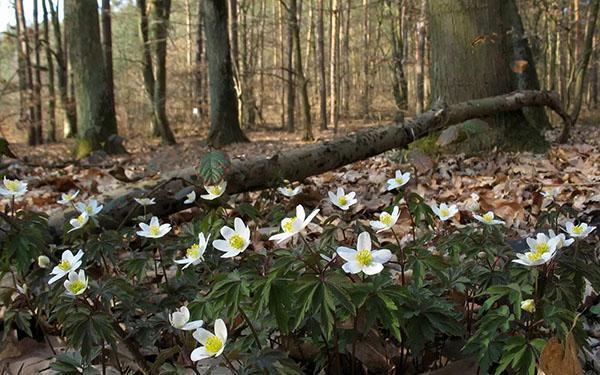A guest from mysterious Siberia - forest anemone
 The snow-white forest anemone with drooping heads is the embodiment of tenderness, grace and stamina. She is considered an example of modesty and humility. Both in buds and in blooming, it looks great. Many are not familiar with this type of culture, although it grows in their environment.
The snow-white forest anemone with drooping heads is the embodiment of tenderness, grace and stamina. She is considered an example of modesty and humility. Both in buds and in blooming, it looks great. Many are not familiar with this type of culture, although it grows in their environment.
The second name of the flower plant is "anemone". Translated from Greek, its botanical name, as noted in the Oxford Encyclopedia, means “daughter of the wind”. According to mythical legend, this flower is a symbol of sorrow.
Forest anemone: several planting requirements
Gardeners have noticed that sophisticated bells look very impressive on thin stems, especially in windy weather. Among the thickets and near the trees, the culture grows rapidly, letting go of abundant growth. Due to its nature, it is often referred to as an aggressive plant. To take control over it will help special restraints in the form of borders or shields, which are buried around the perimeter. In other cases, it is simply removed from the site.
Amazing decor will be made by a company of anemones, irises and fern. Since they have different flowering periods, they will successfully replace each other in a flower bed. Among other things, it is important to know about her that she:
- is a perennial herb;
- propagates by dividing the bush, as well as by seeds;
- unpretentious in care;
- prefers shady areas;
- has a well-developed root system;
- does not tolerate transplants, in this regard, it is planted together with an earthen lump.
Best of all, the forest anemone takes root after dividing the bush. For planting, they dig a hole 20 cm deep. Its bottom is covered with rubble or broken brick so that water does not stagnate in the rhizome. The planting substrate includes:
- river sand;
- peat, in other cases deciduous soil;
- manure.
Each component is taken in equal parts and mixed thoroughly. Then half of the prepared soil is poured onto the drain. Then a seedling with a clod of earth is placed on the formed mound. Then it is watered and covered with soil dug from the hole. In this case, the basal neck is not buried.
The site is recommended to be mulched so that the plant will take root in new conditions. It is enough just to cover the bed with mowed grass or fallen leaves of an apple / pear tree. Layer thickness - 5 cm.
Nuances in care
Forest anemone needs regular, but not too abundant watering. Thanks to the mulch, the moisture under it does not evaporate so quickly, and the weeds practically do not grow. The culture is surprising in that it does not need to be pruned or fertilized. Yet she is afraid of severe frosts. Therefore, the bush is dug up with the rhizome and stored in containers, placed in a cool room. In the spring, the seedlings are transferred to a new place under the open sky.